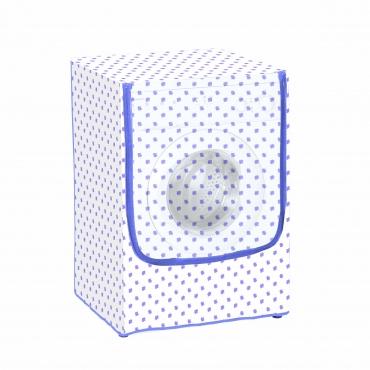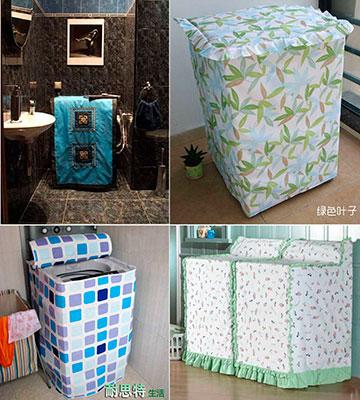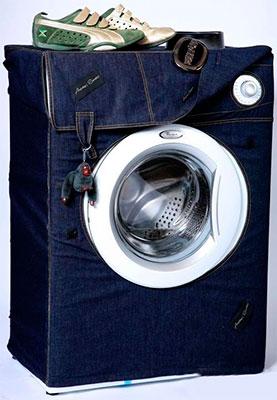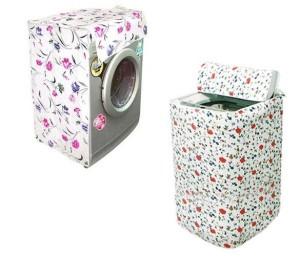The more carefully we treat household appliances, the longer it lasts - every consumer knows this. The same applies to washing machines. In order to protect them from external influences, many users use cases made of various materials. Do you really need a washing machine cover or is it just fashion?
It is quite difficult to answer this question, since many washing machines live and are healthy without covers, without spoiling or being damaged. Therefore, the problem of using covers should be considered as detailed as possible and from all sides. This review is devoted to this topic.
What is a washing machine cover for?

Covers for washing machines can perform two functions:
- Protective;
- Decorative.
As for decor, this is really a great way to give your washing machine an unusual look. For example, using covers of appropriate colors, we can stylize the device under marble or give it cheerful flowers. By making a cover for a washing machine with our own hands, we can give free rein to our imagination and even adapt the machine to the kitchen interior - for example, give it the color of kitchen furniture.
The protective function is manifested in the fact that cover protects the washing machine from external influences. The machine can get scratched or dirty, water spots often appear on it, users often spill detergents and conditioners on the cases, store powders on the top cover, and much more. If there was a cover here, pollution with streaks could have been avoided. The cover in this case allows you to simplify washing machine care.
Is the washing machine in the kitchen? Here it can get dirty even faster than in the bathroom, because in the kitchen it is often exposed to a wide variety of contaminants, such as oil, food coloring, grease. Nothing will happen from one hit, but over time, the body of the machine will become overgrown with hard-to-remove spots and begin to turn yellow. The presentation will be lost, and even if we decide to sell the washing machine, we will have to drop the price dramatically.
The washing machine dressed in a cover will not get dirty powders, conditioners, grease, food leftovers and other contaminants. In addition, the cover will protect the snow-white body of the device from marks of felt-tip pens, pencils and pens, which is important for those who have small children who are always eager to draw on any flat and non-flat surfaces in the house.
So do you still need a cover or not? If your washing machine is constantly exposed to various contaminants, then buying a cover is justified. This applies to those who have the machine in the kitchen, where it can get dirty with food. If buying a case is a whim, then remember the following:
- During washing, the cover must be removed (if it closes the back wall of the machine) to ensure proper air circulation - it is unacceptable that all holes are covered with a cover (there are heating elements and an electric motor inside the machine that need cooling);
- Waterproof covers should be used with care - no moisture left inside the washing machine is allowed, as water evaporation can lead to rust spots;
- It is not so easy to remove and put on covers for a washing machine - it has rather large dimensions.
If nothing bothers you, and you want to provide your machine with an interesting appearance, feel free to go for a cover.
Purchased case

Where to buy a cover for a washing machine? They are sold in hardware stores, but in many cases we will have to run around before we can find a place to sell - cases are not in high demand among consumers.
Purchased covers are made from a variety of materials, but the most popular is polyester - It is a lightweight and durable material that does not allow water to pass through. Covers are made from it as on frontal machines, as well as vertical ones. For example, a 40x60 cm washing machine cover is a typical cover for a vertical model.
The cover can protect the entire washing machine as a whole, or only its upper part. The latter option will become relevant for those who are afraid to stain the top, where anything is often stored, from things to detergents. Those covers that cover the entire machine have hinged "lids" that cover the loading hatch and control panel. Similar "covers" are available in the rear.
Shop covers are quite comfortable and reliable, they provide a good degree of protection. The most popular products of the Rayen brand, which produces covers for many things, including washing machines.
Making your own washing machine cover

You can make a cover for a washing machine yourself. To do this, you need to take measurements and decide on the fabric - oilcloth fabrics that are waterproof are best suited. Color - any, to your taste. By the way, it is this home-made covers that win over monotonous store options.
When creating patterns for the cover, do not forget to mark the folding "covers" that will open the back and front of the machine. As fasteners, you can use elastic bands, buttons or Velcro - thanks to the fasteners, the "lids" can be fixed to the top of the machine during washing. You can buy fasteners at any store that sells goods for cutting and sewing.
If necessary, you can sew a cover only for the top of the washing machine.This is useful for those who use the top cover for storing various things and objects - thanks to this, it will be possible to keep it intact and not shabby.
How to use the case correctly

As already mentioned, it is recommended to remove covers for washing machines during washing in order to ensure proper ventilation provided by the manufacturer and you do not have to get rid of mold inside the washer. In extreme cases, you need to remove or lift the back of the cover. At all other times, the machine can remain completely closed.
You also need to remember that before using a waterproof cover, the washing machine must be properly ventilated - this will remove moisture from it, which causes rust. Before putting on the cover, do not forget to wipe the machine body with a dry cloth.
